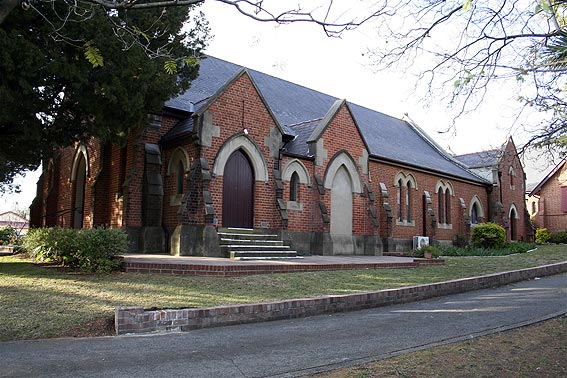
St John's Anglican Church, Tamworth
[Photograph by Trevor Bunning (September 2007)]

St John's Anglican Church, Tamworth
[Photograph by Trevor Bunning (September 2007)]
Historical and Technical Documentation by Geoffrey Cox
© OHTA 2014 (last updated April 2014)
St John's Anglican Church was opened by Bishop James Turner, the Bishop of Grafton and Armidale, on Sunday 13 February 1881.1 An organ by J.W. Walker & Sons of London had been ordered from the outset, and it was being erected in the church by August that year:
NEW ORGAN FOR ST. JOHN'S CHURCH, TAMWORTH. - The Tamworth Observer of Wednesday says:- Mr. Broderick, the well-known organ builder, of Maitland, is now busily at work erecting the instrument recently imported for St. John's Church. All the cases arrived in very good condition, and although Mr. Broderick was delayed for a day and a half, owing to one case not coming to hand as expected, he has made up for the lost time by working at night. So far, he has the bellows, swell-box, all wind chests, and a great deal of the action in place. Mr. Broderick will have the famous "piccolo" stop in talking form about the end of this week.2
The details of the famous "piccolo" stop remain unclear, as there was no stop on the organ labelled as such. Details of the new organ appear as Job no 1139 in the J.W. Walker Order Book E, as follows:3
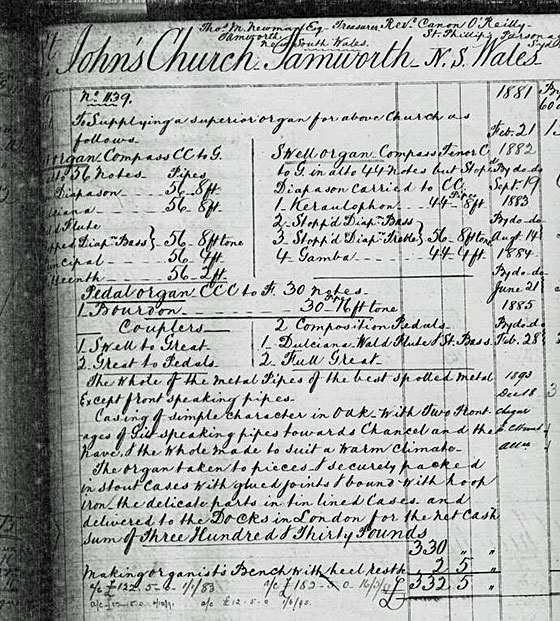
J.W. Walker & Sons Ledger Book E (1875-1884), p. 332.
[J.W. Walker & Sons Ltd, Brandon, Suffolk]
This is transcribed as follows:
St John's Church Tamworth N.S.Wales
No 1139
To Supplying a superior organ for the above Church as
follows.
Great Organ CC to G, 56 notes
Open Diapason
Dulciana
Wald Flute }
Stopped Diap Bass }
Principal
Fifteenth
Swell Organ Tenor C to G, 44 notes
but Stopped Diapason carried to CC
Keraulophon
Stopp'd Diap'n Bass }
Stopp'd Diap'n Treble}
Gamba
Pedal CCC to F, 30 notes
Bourdon
Couplers
Swell to Great
Great to Pedal
8ft
8ft
8ft tone
4ft
2ft
8ft
8ft tone
4ft
16ft tone
2 Composition Pedals [to Great Organ]
1. Dulciana, Wald Flute & St. Bass
2. Full Great
The whole of the Metal Pipes of the best Spotted Metal
except front speaking pipes.
Casing of simple character in Oak with two Frontages
of Gilt speaking pipes towards Chancel and the Nave
& the whole to suit a warm climate.
The organ taken to pieces & securely packed in stout cases
with glued joints & bound with hoop iron. The delicate parts
in tin lined cases and delivered to the Docks in London for the
net Cash sum of Three Hundred & Thirty Pounds
£330 - -
Making organist's Bench with heel rest
£332 5 -
An annotation at the top of the page to "Canon O'Reilly, St Phillip's Parsonage, Sydney" presumably refers to Canon Thomas O'Reilly (1819-1881), who was incumbent of St Philip's, Church Hill, Sydney, from 1869. O'Reilly was involved at Church Hill with the installation of the 1873 J.W. Walker & Sons organ, opened in February 1874.4 The firm of J.W. Walker & Sons exported some 55 or more organs to Australia between 1849 and 1884, at least 40 of which were ordered for New South Wales.5
The new organ at St John's was opened on Sunday 14 August 1881, and a recital was given on the following Friday evening by Signor Lardelli:
The new organ at St. John's Anglican Church was opened last Sunday, and last night Signor Lardelli, of Sydney, gave a recital. About 400 people were present. The organ cost £330 in England, and was built by Walker and Sons. It is considered an excellent instrument.6
Signor Lardelli was to have given a second organ recital on the evening of Wednesday 5 October,7 but the event was cancelled at the last minute because of a failure in the organ's winding:
THE PROPOSED ORGAN RECITAL AT TAMWORTH. - We learn from the Tamworth Observer, that the organ recital which was to have been given on Wednesday evening at St John's Church by Signor Lardelli, had to be given up through the instrument being out of order, and the audience were dismissed. At 10 o'clock on Wednesday night, a telegram was despatched to Mr Broderick, organ builder, Maitland, requesting him to come at once to put St Johns organ right. Mr Broderick reached Tamworth by the 4 o'clock train on Thursday, worked at the organ with the Hon. Organist, for five hours, and left it in perfect order and tune, returning to Maitland by the 3 a.m. train. Mr Broderick has put the organ in thorough order; and as there is now a full pressure of wind, the tone is considerably increased in brightness and volume. The collapse on Wednesday evening was caused for the most part by the splitting of one of the wind ducts, the result no doubt, of the change of temperature on Tuesday.8
Some four decades later, in 1920, there were moves to renovate the organ:
An appeal is shortly to be made to the congregation for funds, wherewith to renovate and improve the pipe organ. The present organ in many respects is an excellent one, but it has been felt for some time that certain renovations are required, and the opportunity will be taken at the same time to add several improvements which will make the instrument a first-class one in every respect. Miss F. Cousens has been appointed organist, in the place of Mrs. F. Brown, who is at present in Queensland.9
The fund raising contined slowly,10 and the organ was eventually rebuilt by Whitehouse of Bros of Brisbane in 1925 at a cost of £315.11 This was the firm's first contract in New South Wales, followed soon afterwards by a similar one for rebuilding the organ at St Alban's Anglican Church, Quirindi. Whether or not there were any stops added in 1925 at Tamworth is not recorded, but the work probably involved the conversion of the action to tubular-pneumatic with the use of cone-pallet chests. 'Cleaning, repairing & tuning pipe organ' at a cost of £57.15. 0 were recorded in March 1942.12
The organ was rebuilt with electro-pneumatic action in 1958 by Whitehouse Bros of Brisbane.13 The original two 'frontages' to the nave and chancel respectively had by this stage been re-configured, and the organ had been re-positioned at the rear of the church. Whether these changes occurred in 1925 or 1958 is not recorded.
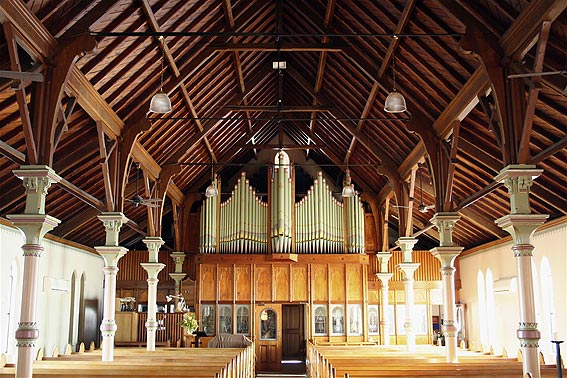
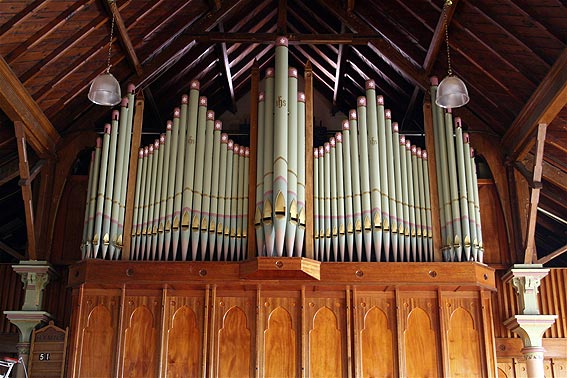
The 1881 J.W. Walker & Sons organ,
rebuilt and enlarged by Whitehouse Bros in 1925 and 1958
[Photographs by Trevor Bunning (September 2007)]
The specification at this stage was of 14 speaking stops, 7 couplers and electro-pneumatic action. The dates and derivations from the 1881 organ given below are speculative:
| Great Open Diapason Dulciana Wald Flute Principal Suabe Flute Fifteenth Swell Violin Diapason Stopped Diapason Keraulophon Celeste Gemshorn Oboe Pedal Bourdon Bass Flute |
8 8 8 4 4 2 8 8 8 8 4 8 16 8 |
A A |
[1881] [1881] [1881] [1881] [1925 or 1958] [1881] [1925 or 1958; lowest octave unenclosed] [1881] [1881] [1881, ex Gamba 4ft?] [1925 or 1958] [1925 or 1958] [1881] [1925 or 1958] |
Couplers
Swell Super
Swell Sub
Swell to Pedal
Swell to Great
Swell to Great Sub
Swell to Great Super
Great to Pedal
Swell tremulant
Compass: 59[recte 61?]/30
2 thumb pistons to Swell
2 thumb pistons to Great
Electro-pneumatic action.14
The current specification, as noted from photographs by Trevor Bunning in September 2007, includes additions made in more recent years. These appear to include stops derived by extension from existing ranks and additional accessories:
| Great Open Diapason Violin Diapason Dulciana Wald Flute Principal Suabe Flute Fifteenth Hohl Flute Clarinet Clarinet Swell Stop Diapason Keraulophon Celeste Gemshorn Piccolo Oboe Pedal Bourdon Octave Diapason Bass Flute [Blank] |
8 8 8 8 4 4 2 2 8 4 8 8 8 4 2 8 16 8 8 |
A A |
[1881] [1925 or 1958; formerly on Swell] [1881] [1881] [1881] [1925 or 1958] [1881] [?] [?] [?] [1881] [1881] [1881, ex Gamba 4ft?] [1925 or 1958] [?] [1925 or 1958] [1881] [?] [1925 or 1958] |
Couplers
Swell Super
Swell Sub
Swell to Pedal
Swell to Great
Swell to Great Sub
Swell to Great Super
Great to Pedal
Swell tremulant
Compass: 61/30
Detached stop-key console
Balanced swell pedal
Crescendo pedal [?]
Electro-pneumatic action.15
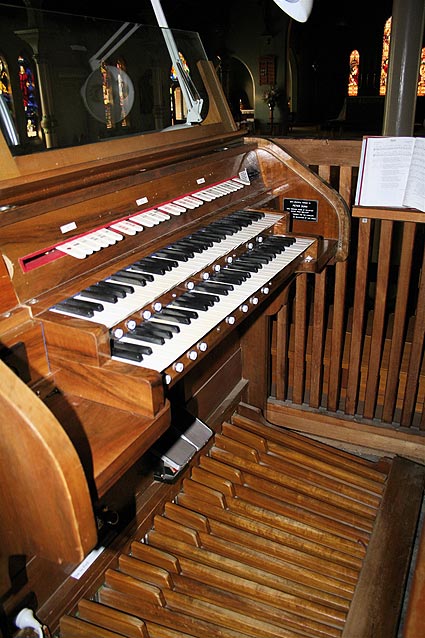
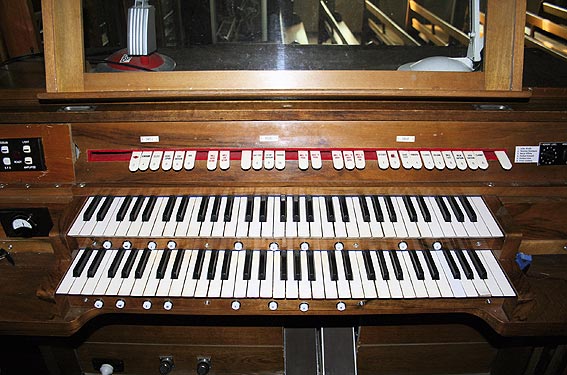
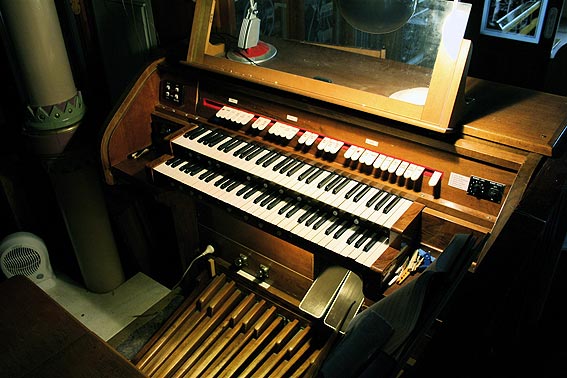
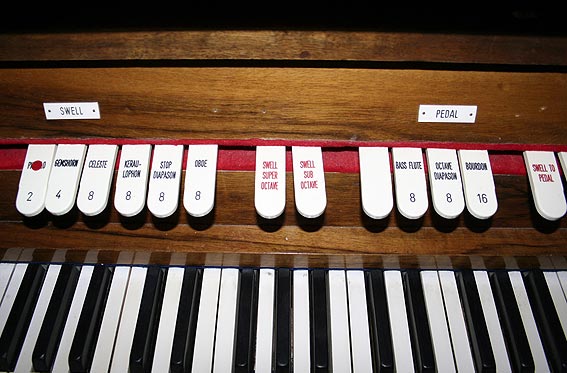
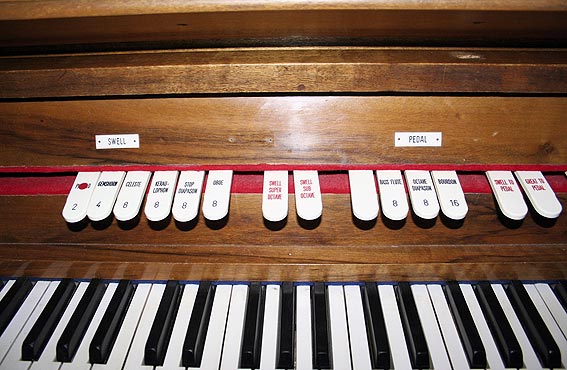
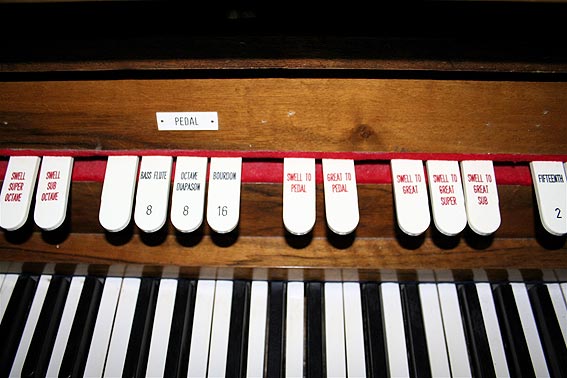
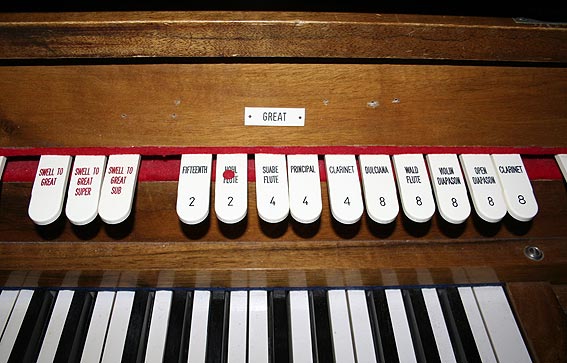
Console and console details
[Photographs by Trevor Bunning (September 2007)]
______________________________________________________________________________
1 Evening News (10 February 1881), p. 2; The Sydney Morning Herald (15 February 1881), p. 5.
2 The Maitland Mercury and Hunter River General Advertiser (6 August 1881), p. 4.
3 J.W. Walker & Sons [Brandon, Suffolk], Ledger Book E (1875-1884), p. 332.
4 Neil O'Reilly, 'O'Reilly, Thomas (1819–1881),' Australian Dictionary of Biography, National Centre of Biography, Australian National University, http://adb.anu.edu.au/biography/oreilly-thomas-4339/text6985 - published in hardcopy 1974, accessed online 11 April 2014.
5 Graeme Rushworth, Historic Organs of New South Wales (Sydney: Hale & Iremonger, 1988), pp. 334-343.
6 The Maitland Mercury and Hunter River General Advertiser (20 August 1881), p. 2 S.
7 Evening News (4 October 1881), p. 2.
8 The Maitland Mercury and Hunter River General Advertiser (11 October 1881), p. 4.
9 The Daily Observer (1 May 1920), p. 5.
10 The Daily Observer (31 July 1920), p. 5.
11 Whitehouse Bros Ledger (1922-1940), p. 110. The final payment was recorded in October 1925.
12 Whitehouse Bros Ledger (1940-1954), p. 231.
13 Date and details supplied to John Maidment by Ron Greer, Tamworth (October 1976).
14 Specification supplied to John Maidment by Ron Greer, Tamworth (October 1976); This was the basis for details provided in John Maidment, Gazetteer of New South Wales Pipe Organs (Melbourne: Society of Organists (Vic) Inc., 1981), and in Graeme Rushworth, op. cit., p. 207.
15 Specification derived from photographs by Trevor Bunning (September 2007).
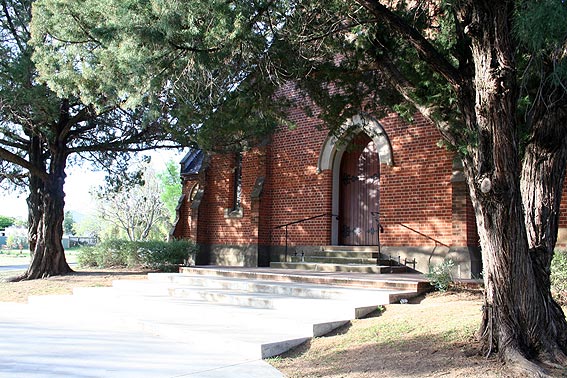
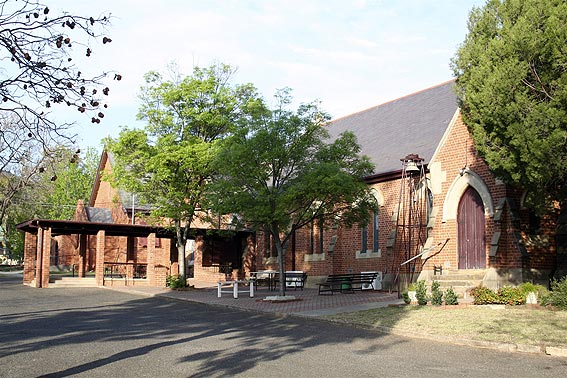
[Photographs by Trevor Bunning (September 2007)]